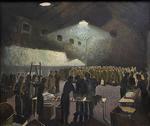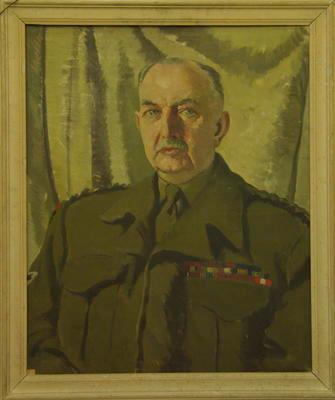Framed oil painting depicting the British Red Cross issuing comforts to prisoners of war upon their arrival in Brussels
Maker and role
Doris Zinkeisen (b.1898, d.1991): Artist
Production date
1945
Audio tour
See full details
Details
Description
The painting shows a British Red Cross relief team issuing comforts to prisoners of war at an air strip in Brussels before they were flown home at the end of the war. Relief items provided by the British Red Cross to prisoners of war being repatriated included comfort bags, each containing essentials such as toothpaste and toothbrush, shaving equipment, face cloth, soap, cigarettes and even chocolate.
The Second World War in Europe ended on the 8th of May in 1945 and was marked by VE, or Victory in Europe Day. The end of the war closed, or reduced, some of the activities of the Joint War Organisation, such as the provision of food parcels for prisoners of war. However, in the immediate aftermath, many of the organisation’s services were still needed and therefore continued for some years. Many members of the British armed forces who were still in hospital in Germany and elsewhere required comforts. Ambulance and welfare officers continued to be needed overseas. Auxiliary hospitals and convalescent homes were still needed in the UK for the sick and wounded who had not recovered, and family tracing for people who were displaced as a result of the war.
VE Day also prompted the formation of some new services. This included the repatriation of prisoners of war, civilian relief services in Europe and welfare services for disabled servicemen and civilians.
Doris Zinkeisen was one of the few female war artists of the Second World War. Doris offered her services as a war artist at a time when the artistic portrayal of war was very much a man’s territory.
Travelling around Northwest Europe by lorry or air, Doris sketched images in different places and then transformed them into oil paintings in her studio in Brussels. As an artist, Doris was commissioned to record what she saw for the British public. In those years before TV cameras and 24-hour news, people relied on photographs and paintings to illustrate what war was really like.
The role of women during the First and Second World Wars is often remembered as consisting of nursing and caring for injured soldiers and civilians. However, their art shows that women’s contribution to humanitarian work during the wars went beyond this. Although few in number, Doris Zinkeisen and other female artists played a crucial role in portraying and interpreting war, ensuring it was not seen just through men’s eyes.
Audio recording by Mehzebin Adam (Curator, British Red Cross Museum & Archives).
The Second World War in Europe ended on the 8th of May in 1945 and was marked by VE, or Victory in Europe Day. The end of the war closed, or reduced, some of the activities of the Joint War Organisation, such as the provision of food parcels for prisoners of war. However, in the immediate aftermath, many of the organisation’s services were still needed and therefore continued for some years. Many members of the British armed forces who were still in hospital in Germany and elsewhere required comforts. Ambulance and welfare officers continued to be needed overseas. Auxiliary hospitals and convalescent homes were still needed in the UK for the sick and wounded who had not recovered, and family tracing for people who were displaced as a result of the war.
VE Day also prompted the formation of some new services. This included the repatriation of prisoners of war, civilian relief services in Europe and welfare services for disabled servicemen and civilians.
Doris Zinkeisen was one of the few female war artists of the Second World War. Doris offered her services as a war artist at a time when the artistic portrayal of war was very much a man’s territory.
Travelling around Northwest Europe by lorry or air, Doris sketched images in different places and then transformed them into oil paintings in her studio in Brussels. As an artist, Doris was commissioned to record what she saw for the British public. In those years before TV cameras and 24-hour news, people relied on photographs and paintings to illustrate what war was really like.
The role of women during the First and Second World Wars is often remembered as consisting of nursing and caring for injured soldiers and civilians. However, their art shows that women’s contribution to humanitarian work during the wars went beyond this. Although few in number, Doris Zinkeisen and other female artists played a crucial role in portraying and interpreting war, ensuring it was not seen just through men’s eyes.
Audio recording by Mehzebin Adam (Curator, British Red Cross Museum & Archives).
Collection Type
Objects
Media/Materials
Inscription
Painted: Doris Zinkeisen 1945
Catalogue Number
0012/3
Associated Person and Role
North West Europe Commission (Joint War Organisation)
Associated Person
Subject auto tags
Object Types
Part of 1 highlight set
Share
All images are the property of the British Red Cross Museum and Archives (unless otherwise indicated), and cannot be used without permission. For queries about permission to use images, please contact enquiry@redcross.org.uk.


-1%20(002).jpg)
